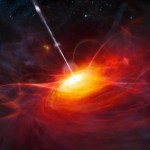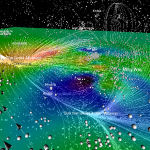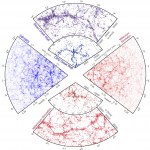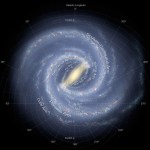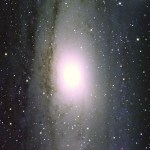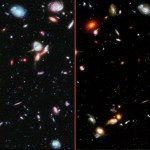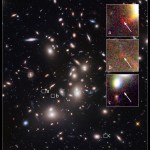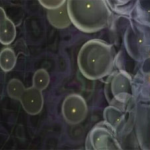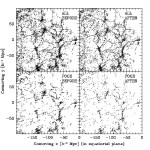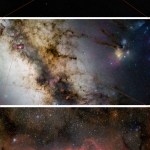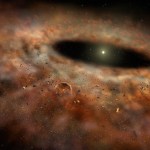Galaxies
"Equipped with his five senses, man explores the universe around him and calls the adventure Science." -Edwin Hubble
Back in the 1920s, Einstein's general relativity had just come out and gained acceptance, and a debate was raging over whether the spirals in the sky were within our own galaxy, or were entire galaxies unto themselves.
Image credit: E. Hubble, NASA, ESA, R. Gendler, Z. Levay and the Hubble Heritage Team, via http://apod.nasa.gov/apod/ap110701.html.
Not only did Edwin Hubble put that debate to rest, discovering that they were galaxies, but he measured their distances and…
"Based on our understanding of how galaxy clusters grow from the very beginning of our universe, this cluster should be one of the five most massive in existence at that time." -Peter Eisenhardt
While deep galaxy surveys from telescopes like Hubble are great for identifying distant individual galaxies, they're not wide-field enough to find massive clusters. Similarly, wide-field surveys like SDSS don't go deep enough to find the most distant clusters.
Image credit: NASA/JPL-Caltech/UCLA, for the WISE mission.
But thanks to the all-sky infrared survey performed by NASA's WISE mission,…
“Unless one says goodbye to what one loves, and unless one travels to completely new territories, one can expect merely a long wearing away of oneself and an eventual extinction.” -Jean Dubuffet
The Universe is in its heyday right now: hundreds of billions of galaxies are visible from any point, clustered together in a glorious cosmic web, with millions, billions or even trillions of stars burning inside of each one. Yet none of this will last forever.
Image credit: the small star forming region NGC 346, from A. Nota (ESA/STScI) et al., ESA, NASA.
If we peer into the far future, any…
When young galaxies are first formed, they're accompanied by tremendous bursts of star formation, giving rise to billions of new stars within just a few million years. Yet how these galaxies first form in the initial stages is very much an open question. In addition, pretty much every large galaxy we find -- even in the extremely young Universe -- has a supermassive black hole at its center.
Image credit: NASA and The Hubble Heritage Team (STScI/AURA).
Is it conceivable that these black holes are the engines of newly formed galaxies? Is it even possible that these black holes preceded…
“From our home on the Earth, we look out into the distances are strive to imagine the sort of world into which we are born.. But with increasing distance our knowledge fades, and fades rapidly, until at the last dim horizon we search among ghostly errors of observations for landmarks that are scarcely more substantial. The search will continue. The urge is older than history. It is not satisfied and it will not be suppressed.” -Edwin Hubble
The deeper we look out into the Universe, the farther back in time we look. Our largest, deepest surveys have shown us not only galaxies in the very…
“The slow philosophy is not about doing everything in tortoise mode. It’s less about the speed and more about investing the right amount of time and attention in the problem so you solve it.” -Carl Honore
If you wanted to know how fast you were moving through space, you'd need to measure it all: the Earth's rotation, our motion around the Sun, the Sun's motion through the galaxy, the Milky Way's speed within the local group, and finally how the local group moved relative to the Universe. All in all, it's a daunting, virtually impossible task without literally measuring everything in the…
“First, you should check out my house. It’s, like, kinda lame, but way less lame than, like, your house.” -Lumpy Space Princess, Adventure Time
When you visualize our Universe today, you probably think about the great clumps of matter -- planets, stars, galaxies and clusters -- separated by huge distances. But on the largest of all scales, tens of billions of light years in diameter, any given region of the Universe is virtually indistinguishable from any other.
Image credit: ESA/Herschel/SPIRE/HerMEs, of the Lockman Hole.
But this structured Universe only came about because our Universe…
When you close your eyes and picture a galaxy, what pops into your mind? For most people, it's a beautiful, spiral shape, where a bright central region fans out with arms that wind around and around, over and over, littered with brilliant, glittering stars. And in almost all the pictures you see, there are two main arms making this up, with perhaps additional "spurs" shooting off of the primary arms.
Image Credit: NASA/JPL-Caltech/ESO/R. Hurt.
But is this really representative of what galaxies look like? Or is it just that these are the images of galaxies that stand out most for us?…
“Our knowledge of stars and interstellar matter must be based primarily on the electromagnetic radiation which reaches us. Nature has thoughtfully provided us with a universe in which radiant energy of almost all wave lengths travels in straight lines over enormous distances with usually rather negligible absorption.” -Lyman Spitzer, Jr.
There's nothing quite like looking at a galaxy, all aglow with the light from billions upon billions of stars shining at once. Some reaches our eyes, some is obscured by light-blocking dust, and all of it comes together to give a spectacular sight.
Image…
“The progress of science is strewn, like an ancient desert trail, with the bleached skeleton of discarded theories which once seemed to possess eternal life.” -Arthur Koestler
For every galaxy out there, what we typically see -- the stars -- is only representative of a tiny fraction, maybe 2%, of all the mass that's present within. For everything else, there's dark matter, planets, gas, dust, molecular clouds and more.
Image credit: Dobbs et al. (simulation snapshot) of the Milky Way’s “bones,” via http://milkywaybones.org/media-gallery/detail/13836/54371.
But while other galaxies tended…
“The world exploded into billions of atoms, and when it rearranged itself, it may have looked the same, but really, it was a Whole New World.” -Claire LaZebnik
At the center of almost every galaxy is a supermassive black hole (SMBH); at the center of almost every cluster is a supermassive galaxy with some of the largest SMBHs in the Universe. And every once in a while, a galactocentric black hole will become active, emitting tremendous amounts of radiation out into the Universe as it devours matter.
Image credit: NASA/CXC/Ohio U./B.McNamara, via http://chandra.harvard.edu/photo/2005/ms0735/…
“We live in a world that has narrowed into a neighborhood before it has broadened into a brotherhood.” -Lyndon B. Johnson
When you think of our own cosmic backyard -- our planets, Sun, the nearby stars, and even the closest galaxies to us -- you probably don't think of them in the context of the entire Universe. But if you want to understand where we come from and how we got to be this way, perhaps you ought to.
Image credit: J. W. Inman, of NGC 2543, via http://www.jwinman.com/starcharts/NGC%202543%20chart.htm.
We could have been a single, isolated galaxy hanging out all by our lonesome…
“It is by going down into the abyss that we recover the treasures of life. Where you stumble, there lies your treasure.” –Joseph Campbell
Imagine you just stared into darkness, collecting every photon of light that came by. What would you wind up seeing? The Hubble Space Telescope has done this many times, creating the Hubble Deep Field first and then the Hubble Ultra Deep Field with upgraded cameras and more time. But most recently, the eXtreme Deep Field has surpassed even that.
Image credit: NASA, ESA, G. Illingworth, D. Magee, and P. Oesch (University of California, Santa Cruz), R.…
When you think of the Hubble Space Telescope, perhaps you think of what's touted as its most major feat of all: peering off into deep, dark space, collecting light, and discovering the plethora of distant galaxies laying billions of light years beyond our own.
The Hubble Space Telescope’s Ultra Deep Field. Prior to the Fronier Fields program, this was the deepest look into the Universe available to human kind. Credit: NASA, ESA, H. Teplitz, M. Rafelski (IPAC/Caltech), A. Koekemoer (STScI), R. Windhorst (Arizona State University), and Z. Levay (STScI).
It's a spectacular sight and a…
“Since man, fragment of the universe, is governed by the same laws that preside over the heavens, it is by no means absurd to search there above for the themes of our lives, for those frigid sympathies that participate in our achievements as well as our blunderings.” -Marguerite Yourcenar
Galaxies are everywhere we look in the Universe, clustered together in groups and separated by voids. It stands to reason that if we look beyond the local group, one of those galaxies would have to be the brightest. But the one that is turns out to be most unusual.
Image composite credit: X-ray: NASA/UMass/…
“Is no one inspired by our present picture of the Universe? This value of science remains unsung by singers, you are reduced to hearing not a song or poem, but an evening lecture about it. This is not yet a scientific age.” -Richard Feynman
There are many scientific facts that are simply remarkable when it comes to the Universe, including the stories of the stars, of galaxies, of matter, of life, of atoms and of subatomic particle. In short, every aspect of nature we can think of has its own unique, remarkable story.
Image credit: NASA, ESA, HEIC, Hubble Heritage Team (STScI/AURA).…
“On a cosmic scale, our life is insignificant, yet this brief period when we appear in the world is the time in which all meaningful questions arise.” -Paul Ricoeur
What you see is what you get, except when it isn't. We're all familiar with Hubble's law, or the notion that the Universe is expanding, and that the farther away you look, the faster you'll see that distant galaxy moving away from you. This relation would be exact, if only the rest of the objects in the Universe didn't exert gravitational forces on one another.
Image credit: Cosmic Flows Project/University of Hawaii, via http://…
“The Milky Way is nothing else but a mass of innumerable stars planted together in clusters.” -Galileo Galilei
It is, in fact, almost exactly as Galileo said.
Image credit: ESO / S. Brunier, from the Gigagalaxyzoom project.
Galileo missed a few things, though, including a plethora of unclustered stars, dust, nebulae and star-forming regions as well.
Image credit: ESO / Stephane Guisard / S. Brunier, via http://www.eso.org/public/images/eso0936b/.
Want to view it all at once? Check out today's Mostly Mute Monday!
“I think if I had to choose, I would rather have gravity instead of zero gravity. It’s fun for a while, but I’d rather live on Earth.” -Kevin A. Ford
By now, you've probably had a lot of opportunities to think about what holds our Universe together: the incredible force of gravitation. Although it's the weakest known force in the Universe, there seems to be no limit to how much mass you can collect in one place. And so on the largest scales -- like solar systems, stars and galaxies -- it seems to be the only force that matters.
Image credit: © 1998–2015 Lynette R. Cook.
Yet the matter that…
“He who would search for pearls must dive below.” -John Dryden
Sometimes falling can be a painful thing, as Ween might sing you in their ominous composition,
Falling Out,
but sometimes it can be absolutely wonderful, like when the Hubble space telescope allows you to "fall in" to the closest large galaxy to us: Andromeda.
Image credit: NASA, ESA, J. Dalcanton, B.F. Williams, and L.C. Johnson (University of Washington), the PHAT team, and R. Gendler.
Thanks to the Panchromatic Hubble Andromeda Treasury (PHAT), we can now give you high-resolution glimpses into our nearest…



